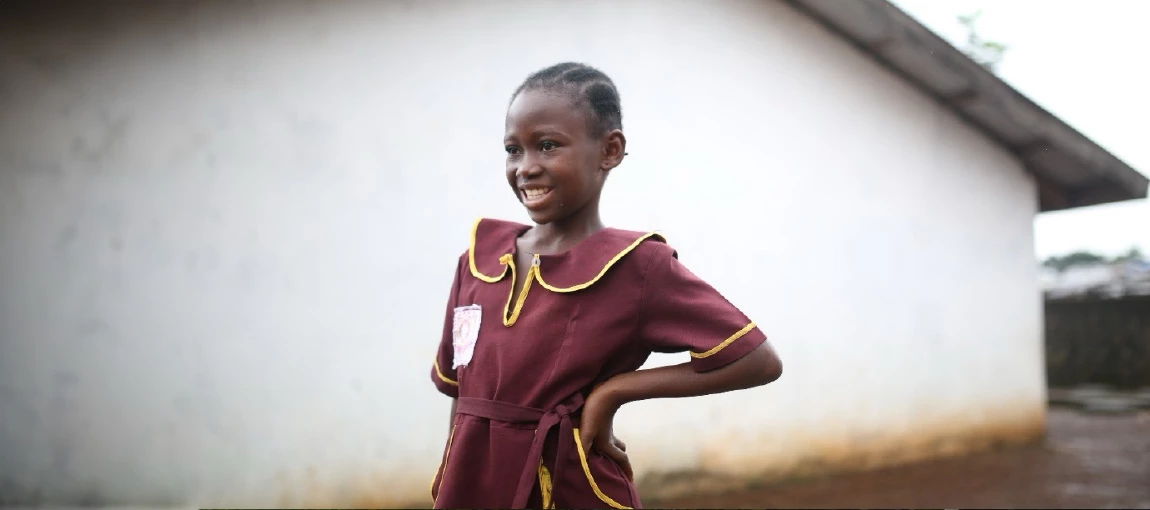 Portrait of schoolgirl in Liberia. Photo: Dominic Chavez / The World Bank
Portrait of schoolgirl in Liberia. Photo: Dominic Chavez / The World Bank
The increasing frequency of multiple crises have upended development progress in the poorest countries. For Sub-Saharan Africa, unprecedented shocks – including the COVID-19 pandemic, a wave of coups, severe climate change impacts, growing food insecurity, and forced displacement, among others – have both immediate and long-lasting impacts on human capital accumulation, productivity and economic growth. In addition to the increasing fragility and conflict in the region, the population in sub-Saharan Africa is projected to double by 2050 making the task of poverty eradication ever more challenging. If the region is to harness a demographic dividend amidst poly crisis, countries must double down on their investments in girls’ educational opportunities that lead to a well-prepared labor force.
For adolescent girls, who often bear the brunt of poverty and violence, these crises run the risk of leaving them even further behind. More girls are in school now than ever before, yet across sub-Saharan Africa, approximately 34 million adolescent girls of secondary school age remain out of school. Girls are also less likely than boys to complete secondary education, often due to child marriage, early pregnancy, and domestic responsibilities. Last year, the completion rate at the lower secondary education level for girls in the region was, on average, 47%, and 27% at the upper secondary level, according to UNESCO data. These national figures do not even capture the reality for the most vulnerable girls – those that are predominantly rural, poor, and persistently out of school.
The challenges of adolescent girls’ enrollment, attendance, and dropout rates are compounded in fragile and conflict-affected situations, which makes up approximately 40% of countries in Sub-Saharan Africa. The region has experienced a large-scale increase in the number of children affected by crises, driven primarily by significant droughts and the increasing intensity of several conflicts. Yet even in crises, girls consistently show a strong learning potential when given the opportunity.
The evidence is compelling and persistent: Investing in girls' education yields significant returns for individuals, communities, and countries. For countries, the cost of not educating girls is estimated in the range of $15 to $30 trillion in lost lifetime productivity and earnings. For each additional year of schooling, girls benefit through higher future earnings, delayed fertility, and reduced adolescent marriages while also promising better outcomes for their future children. UNESCO estimates that if all girls completed secondary education, child marriage would drop by 64%. Reaching girls during adolescence is imperative because decisions made and behaviors established during this period can affect their life trajectory.
Armed with knowledge and substantial financing, the World Bank seeks to help countries seize the opportunity to empower women by investing in girls’ education. The Bank’s approach to supporting girls’ education recognizes that multiple constraints lead to low enrollment rates, low learning levels, and high dropout rates, as illustrated below:

There is a growing evidence base on what works to address the above constraints to getting and keeping girls in school.
When financial barriers exist, poverty-targeted cash transfers and education grants can improve girls’ school attendance, grade completion, and test scores alongside reduction in early marriage, childbearing and risky sexual behavior. Relatedly, secondary school scholarship programs for girls have shown to boost educational attainment. School feeding is another promising way to boost student learning and attendance, especially in food-insecure contexts and particularly for girls. There is also evidence that school feeding interventions scale well. The World Bank’s Girls Empowerment and Learning for All Project in Angola provides scholarships to 900,000 youth, with a school registration bonus for girls. Similarly, the Adolescent Girls Initiative for Learning and Empowerment Project in Nigeria will provide scholarships to 500,000 girls from the poorest backgrounds for their retention in secondary school. For a cost-effective alternative to cash transfers, the provision of supplies such as school uniforms and bicycles to girls can also increase school enrollment, reduce adolescent girls’ dropout, improve grades and delay marriage.
Further, safe-space programs or girls’ clubs that deliver critical life skills training and mentorship to girls have shown to reduce school dropout, adolescent pregnancy, boost economic empowerment, and improve attitudes towards gender equality. World Bank projects have supported the creation of girls’ clubs in the Sahel, Haiti, Ethiopia, India, São Tomé and Príncipe, Tanzania, Malawi, and Lesotho, among others. The results show that these interventions can be effective even in the face of large-scale shocks. For example, a program to introduce girls’ clubs in Sierra Leone found that after the Ebola crisis, girls in villages without these clubs were twice as likely to drop out of school than girls in villages with these clubs.
There has been some evidence that designing safe, girl-friendly schools through infrastructure improvements and incentives can increase school enrollment and test scores. The Girls Empowerment and Quality Education for All Project in São Tomé and Príncipe, for example, aims to provide safe learning spaces for all girls. Yet greater evidence and data are needed on the impacts of school-based interventions for girls, such as making schools safer for girls, separate toilets, and gender-based violence reduction mechanisms.
Engaging men and boys, parents, teachers, and community leaders is also key to preventing gender norms from negatively impacting adolescent girls’ learning and future opportunities. However, few studies have been conducted on what works in this area. World Bank projects in Angola and Nigeria worked with parents and community leaders through a series of activities focused on increasing adolescent girls’ enrollment in school. After the COVID-19 school closures and in response to an anticipated reduction in girls’ enrollment, World Bank projects in Chad, Sudan, Bangladesh, Benin, Ethiopia, and Uganda all ran advocacy campaigns for girls’ re-enrollment in schools.
In the face of mounting development challenges, decisive action is critical to ensure all adolescent girls in Africa have access to quality education in the immediate term, while continuing to focus on their successful completion of secondary school and transition into the labor force in the medium-term. Meeting the moment requires ramping up ambition and resources through evidence-based interventions to empower adolescent girls to reach their full human potential.


Join the Conversation